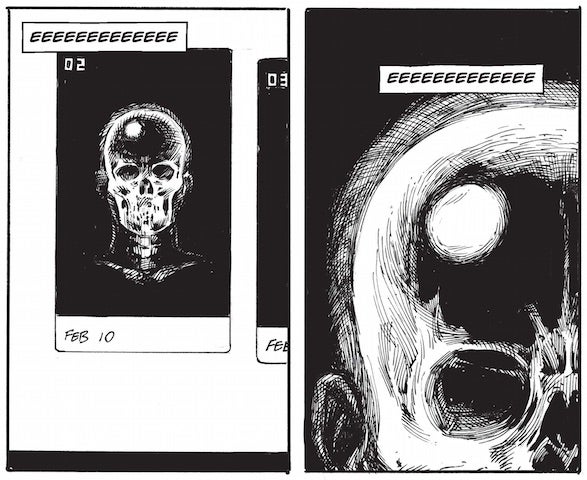Earlier this month, DC released the first six pages of Doomsday Clock #1, and there is a lot to unpack.
Videos by ComicBook.com
Writer Geoff Johns has said that he and artist Gary Frank can spend hours poring over a single panel, and that effort shows in what has been released so far: the six pages made available to fans at New York Comic Con are packed with content, plot, dialogue, meaning, and politics.
So much so, in fact, that when we sat down to try and break down the first six pages, we found that 2,000 words in, we had just barely finished writing about the first page.
You can check out our deep dive into the first page of the miniseries here, the second page here, and the third page here. Here is our look at the fourth.
Let’s get moving through the page — and let us know if we (somehow) missed something at @comicbook!

Panel 1
The use of the word “exploded” figuratively, juxtaposed with a literla explosion at Ozymandias’s compound, is an interesting creative choice.
Here, we get a reference to the New York Gazette, the paper of record in the world of Watchmen. As we alluded to in our breakdown of page 3, it is the Gazette which is credited with breaking the Ozymandias story (“The Big Lie”) wide open, rather than The New Frontiersman, to whom Rorschach mailed his journal at the end of Watchmen.

Panel 2
Here we get the first reference to the “final independent broadcasts” and to the launch of the “National News Network.
Given the importance of a free press in democratic societies, it is likely Johns intends this to be representative of a slow creep toward authoritarianism.
Given the adversarial relationship between real-world U.S. President Donald Trump and the news media, it is possible that what is to come has some amount of Trump commentary baked into it. We will explore that more soon.

Panel 3
As each network signs off, we get a shot of the wall of news monitors where Ozymandias spent so much of his time, immersed in information, in Watchmen.
It is interesting that while Ozymandias spent so much of his time relying on the media to deliver information to him, he did not manipulate them any more than he did everyone else with his lie. That a free press exposed his lie, and the U.S. government is simultaneously hunting him down in order to prove they were not complicit and also shutting down the press that exposed him is likely telling.
The question is: was the media already on the road to state ownership before the Ozymandias news broke, or is Adrian Veidt actually responsible for the collapse of the free press, and the attendant replacement of his precious knowledge with propaganda?
One important side note: Here we get a mention of UBS, the network in Paddy Chayevsky’s classic film Network. More on that to come…!

Slides 4-5
In slide 4, we get a view of one soldier seemingly shocked to see something, while a voice on the TV calls for continued dissent and resistance.
That voice, as it turns out, comes from Howard Beale, the protagonist of Network. A newscaster whose career was on the verge of collapsing, he took to the airwaves to rant and rave about the problems with American popular culture, government, and the media.
You can see his famous scene above.
Panel five opens into a medical laboratory, the first sign of something that will be very important going forward.

Slides 6-7
Someone (who seems likely to be Veidt, although there’s a little Rorschach look to the shape of the head and ears) has a large tumor.
Is it tied to Doctor Manhattan? The idea of those close to him being impacted by cancer was mentioned in passing during the exposition panel on page 3. In that way, it is a callback to Watchmen, whether or not that ends up being something they actually play with.
The February 10 date on the CAT scans indicate that whoever this is, has been unhealthy for a long time. Between February 10 (the date on the scan) and November 22 (the stated date on page 1), this is a condition that has been persistent for the better part of a year.

Slide 8
The broadcast static sound of “eeeeee” and the medical equipment juxtaposed together create an impression or something that is not on the page — in this case, someone flatlining.
Could this be the “death of liberty?” Likely that’s a little too stilted and pretentious for what Johns is trying to do, although the creative team might be foreshadowing a death, or setting up the first half of a bookend for the last issue.
It all culminates in this panel, and the introduction of the National News Network.
Besides the idea of authoritarian regimes who use government ownership of the media, the National News Network may in part be a real-world cautionary tale, since when he was running for President, Donald Trump talked about how he might use his base’s disdain for the mainstream media to launch a TV network that caters news to the alt-right audience — and after taking office, Trump’s campaign team has been creating campaign materials that are designed to look like news broadcasts.









